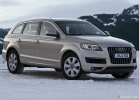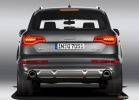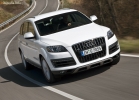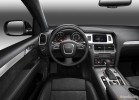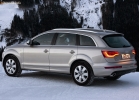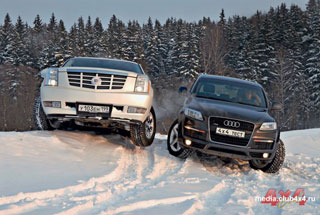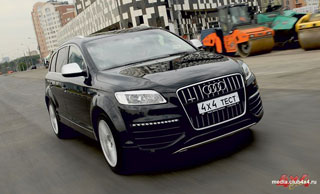Audi Q7 test drive since 2009 SUV
Audi Q7 and TT. Upgrade with his philosophy
 Each automaker cultivates his teaching, and the company's headquarters are not only administrative and technical, but also a kind of spiritual center. In order to know the philosophy of ideal sports control, you should go to the county of Norfolk, where they make lotuses. Little where they are so deeply believed in the style and passion enclosed in cars, as in Milan, the city of Alfa Romeo. In the Goetheborg, Volvo residence, it is known that they are preaching, safety ideas. And the horse of the Germans (albeit not only them) technology is almost in its pure form, design know-how. Take at least the Torsen differential, Audi engineers have always been told about its virtues. But they no longer tell: a new line was born in their views, which came into the world along with the new differential. And in the company they revise engines and the first in the world introduce 8-speed machines in relatively affordable models. Why, the correspondent of [email protected] who visited the homeland of Audi Ingolstadt found out.
Each automaker cultivates his teaching, and the company's headquarters are not only administrative and technical, but also a kind of spiritual center. In order to know the philosophy of ideal sports control, you should go to the county of Norfolk, where they make lotuses. Little where they are so deeply believed in the style and passion enclosed in cars, as in Milan, the city of Alfa Romeo. In the Goetheborg, Volvo residence, it is known that they are preaching, safety ideas. And the horse of the Germans (albeit not only them) technology is almost in its pure form, design know-how. Take at least the Torsen differential, Audi engineers have always been told about its virtues. But they no longer tell: a new line was born in their views, which came into the world along with the new differential. And in the company they revise engines and the first in the world introduce 8-speed machines in relatively affordable models. Why, the correspondent of [email protected] who visited the homeland of Audi Ingolstadt found out. Crossing the area between the terminal of the Munich airport and the Audi Forum building (some 100 meters), I mentally prepared for the fact that today I will have to spend more time not in the driver's seat, but on the conference room. However, the event under the formal name The technical seminar began unusual: after a brief report, we are invited to parking, where a dozen TT and four Q7 were lined up. The idea of \u200b\u200bthe Ingolstads seemed to be like this: ride, they say, and make sure that during the renewal of the car did not lose the traditional advantages of Audi models, although updated cars were developed under the influence of new trends. Which ones?
Refusal of powerful atmospheres on Audi Q7
Direct comparisons with competitors, representatives of Audi of course do not voice unethical. But the alignment of forces is known. The Ingolstadt company much later rivals undertook to produce SUVs, and in those four years that Q7 conquers a share in the market at the BMW X5 and Mercedes GL, the model managed to achieve customers. Last year, Russian customers purchased 1,968 large crossovers with four rings on the radiator grille, which is 652 more than the same GL. Losing to models with a blue-blue propeller, which was only 55 pieces, could be considered insignificant if you forget that BMW, in addition to 2,023 X5 models, sold 2,232 X6 sports SUVs. The success of the Bavarians is natural: their models are more spectacular outwardly and faster on the road. Moreover, the basic 3-liter BMW turbo engine allows you to overtake both Q7 with a 3.6 FSI engine at a parallel start, as well as a version of 4.2 FSI. Moreover, the Bavarian motor is even more economical! For the Western car manufacturer, this is a serious reason to take up the search for new engines instead of these atmosphericians.

Q7 cheerfully gains move. With 333-horsepower V6, acceleration to 100 km/h takes only 6.9 seconds, which is 0.5 seconds less than the version with a 350-horsepower V8
The suitable power unit was discovered in the arsenal of sports sedan and station wagons S4 3.0 TFSI. Contrary to the usual, the letter T in this case means not turbocharged, but a compressor. For Q7, this engine was proposed in two versions: deformed to 272 forces, and in the original 333 hp.

A 3-liter motor with a compressor digests 95th gasoline. For the previous 3.6- and 4.2-liter atmospheres, the 98th was recommended
So, at my disposal a powerful Q7, and ahead is a perfectly flat autobahn connecting the Munich airport and Ingolstadt. A heavy SUV cheerfully responds to gas, immediately provoking the left row. On this car you can really feel that in Germany there are no speed restrictions on highways. I had no desire to scare the respectable Germans, dispersing the car to the maximum 245 km/h, but there is no doubt in the ability of a heavy machine to achieve this value. Supporting the cruising speed of about 200 km/h, you feel that a decent supply of power still remains under the gas pedal. And according to passport data, the 306-horsepower BMW and 333-horsepower Audi should accelerate almost a nostril into a nostril. The mark of 100 km/h Q7 will pass through 6.9 s, which is only 0.1 from later than the opponent, but it will go around it at maximum speed, albeit on a meager 1 km/h.
At the same time, with the task of bringing Q7 to a new level of economy in Ingolstadt, they fully coped. The most interesting thing is that, even having chosen a more forced version, you will not have to put up with an increased fuel consumption. According to Audi measurements, both modifications of the motor consume 10.7 l/100 km in a mixed cycle. For comparison, the eight -cylinder 4.2 FSI burned 16% more.


The SUV interior was updated last year. True, modernization was limited to Apgeide of the MMI multimedia system (up to the third generation), new materials appeared in the range of decoration options, and the rear passengers received a separate climate control
The struggle to reduce fuel consumption is on all fronts. The already very economical 3-liter diesel engine began to spend as much as 19% less fuel (7.4 l/100 km). Actually, the 3.0 TDI engine is practically re -developed. The weight decreased by 20 kg. And the return, as before, is 240 forces.
Eight -speed machines for all models
Like the sedans of the representative class, Q7 now has received an eight -speed automatic transmission, and, presumably, soon such transmission will go to more affordable models. The Ingolstads themselves have not yet commented on such an opportunity, but the journalists of the American publication Autoweek received information from one of the dealers that in the coming months orders for eight -speed A4, A5 and Q5 will begin.

The new eight -speed automatic does not give a significant advantage over the six -speed either in the smoothness of the course or the speed of switching. There are no complaints about both boxes. But fresh automatic transmission allows you to save about 5% fuel
Do you need this innovation? I tried to figure it out in this, listening to my feelings driving an eight -speed Q7. I must say, the smoothness of switching and the six -speed box was on top. The main motive of German engineers is economy. As the main transmission after 100 km/h, the motor uses the eighth. But that's not all. In the Ingolstadt Center, Audi, where the route brought us, engineers are ready to talk about the new automatic transmission for hours. This is not the transmission of ZF, which is placed on A8. For the SUV, Aisin makes a box, and it has its own characteristics. The fuel consumption system is contributed to a decrease in the heating of the box. Hot antifreeze from the engine goes to the machine. So the engineers managed to reduce power loss in automatic transmission while it is cold and the oil in it is thick. And also, as explained in Audi, the new transmission is 11 kg easier. For an SUV weighing 2.2 tons, this is, of course, a trifle. But in general, the result has been achieved: the decrease in fuel consumption is about 5% compared to a six -speed box.

An 8-speed automatic for Q7 makes AISIN (for A8 ZF)
Russian buyers Q7 may not appreciate these efforts. However, the box can be forced to forget about economical higher gears. You convert the machine gun selector into a sports mode, and mainly reduced transmissions are used to keep the engine in tone in the zone of increased revolutions.
Evolution Audi TT
Route number four on the map of the test drive was indicated in black, unlike other tracks of more cheerful tones. So at ski resorts the most complex areas for experienced skiers are noted. In fact, the forest road turned out to be a series of narrow turns, and which the locals do not expect in Germany to meet the speeds of the permitted 100 km/h. But TT here is in its element! Going into turns faster and faster, at first I pull myself: there is no space for slipping here at all. But the coupe does not force one for a second to doubt his abilities. His character became a little more vigorous thanks to the technical improvements that the model received now.

Restyling TT can be found by chains of LEDs in headlights. A spectacular aerodynamic body kit that TTS previously shone was now available as part of the S Line package.
As a racing team is continuously improving the machine during the season, so Audi engineers even in the fourth year of the current generation of TT do not cease to offer technical innovations. Although insignificant, but subordinates to the racing principle: everything for speed.

Although the increase in the power of the motor 2.0 TFSI is small (the return increased from 200 to 211 hp), the difference in dynamics is noticeable: up to 100 km/h, the version with mechanics accelerates in 6.1 s, which is half a second less than before
The car received a modernized version of a 2-liter turbo engine with a system for changes in gas distribution at the inlet, the capacity of which is increased from 200 to 211 forces. Extreme modification TT RS (2.5 liters, 340 hp) acquired an additional seventh step in the pre -sequential box S Tronic.

Simultaneously with the modernization of the 2-liter engine, the V6 (3.2 l) engine fell out of the range of modifications. The next now is the 272-horsepower version of TTS
The ability to change the character of the car on the fly, varying the rigidity of the chassis, a successful idea, and Audi engineers decided to develop it. On the key next to the gearbox lever, instead of the shock absorber, the letter S is now depicted. It not only turns the active suspension into a more rigid mode, but also makes the gas pedal sensitive, the steering wheel is harder, and the sound of the exhaust is more spectacular. If the adjustable suspension is a useful option, then it is quite possible to refuse the SP key proposed for the surcharge. In any case, a 2-liter turbo engine and without an interactive exhaust sounds fervently on TT.

Suspension with adjustable shock absorbers in normal mode is more comfortable than standard, but when moving to a sports regime, vertical buildup disappears completely
Not without traditional restyling elements: modified bumpers, which, however, differ only in more convex contours of air intakes, other materials of the interior decoration, as well as four new coloring options. A saturated blue scuba, red Volkano and two shades of gray Oolong and Dakota were added to the palette. The latter can be ordered with a pearl effect in combination with the S Line package.

In the S Line version, the salon is finished with black skin and alcantara, other configurations are also offered in light colors. The generous finish by aluminum was slightly refreshed, although the difference in the eyes does not catch. The S key transfers the suspension into a hard mode, and also makes gas more sensitive, the steering wheel is slightly heavy and the sound of the exhaust is changing
The disadvantage of the past modernization can be considered that the car has lost the motor between the 2.0 TFSI version and the TTS high -speed modification. We are talking about a 3.2-liter six (250 forces). However, according to many, the V6 made the front part of the compact compartment too heavy, which was harmful to controllability. It is not for nothing that the Ingolstads themselves chose for TTS a 2-liter four, forced up to 272 hp.
Farewell to the torson
Audi can emphasize the continuity of technology, drawing parallels with vivid design ideas of previous years and even centuries. Having entered the exhibition of the exposition of 30 years of Quattro, the first thing I am stumbled upon not the famous rally Audi Quattro model of 1980, but on the layout of a strange four -wheeled ark, the design of which dates from 1485. The guide that is not without a sense of humor admits that this vehicle, invented by Leonardo da Vinci, most likely has never been built, but if you determine the origins of Ingolstad developments, then it is a prototype. Through the slot in the roof of this apparatus it is clear that four people should have been given in motion, each of whom rotated its wheel. Further, for four hundred years, there were no significant jumps in Quattro technology.

The vehicle, invented by Leonardo da Vinci, had four drive wheels, and it was this ark that the auditors are jokingly called the prototype of QUATTRO technologies
But the whole twentieth century is a continuous search for the best transmission 4x4. The exhibition collected by Audi shows not only its own developments, but also the paths along which the design thought of other companies came. The key issue of the development of all -wheel drive models: in which way to distribute the thrust between the front and rear axle. Today, most crossovers and cars with a 4x4 transmission have a connected four -wheel drive, for example, based on a multi -disc couple controlled by electronics. Audi has been using a different option for many years. Pure mechanics: constant all -wheel drive with Torsen differential. And the fans of the brand may be upset that this development is now being prepared to rest.

Quattro all -wheel drive technologies were debuted in the rally in 1980 and almost immediately went into the series. The first transmission 4x4 received Audi 80 (in the photo on the right), and at the moment there are no models that do not have all -wheel drive versions in the gamut of the Ingolstadt company (except for the miniature A1)
However, as explains Dieter Weidemann, a representative of the Quattro Developers team, Torsen is far from ideal. It changes the distribution of traction between the front and rear wheels in insufficiently wide limits: in ordinary modes, the front wheels get 40% of the power, and if there is a slip of 60%. In addition, Torsen is relatively expensive.

Today in the world of motorsport, all-wheel drive is associated with rally, and fifty years ago, 4x4 transmission had Formula-1 cars such as this Ferguson Climax P99 (in the photo on the left). Lotus 63 (right) is only eight years younger than Ferguson, but the aerodynamics changed radically, and the all -wheel drive remained

The Inholstads developed in 1971, developed in 1971, also consider a certain milestone in the development of 4x4 technologies
Among the mock -ups of engines and transmission shining in the Ingolstadt Center, the stand with a new differential looks completely inconspicuous. And the knot itself with open insides is unusually simple.

The new center differential, which has replaced by Torsen, is very compact and weighs only 4.8 kg, however, is able to digest the torque of even the most powerful engines from the Audi gamut
In order not to go into technical details, I will explain the main principle of the new system. This differential is made in a common block with a multi -disc coursed that is responsible for blocking. But it is not clamped by the command of electronics. Here the entire structure is completely mechanical. In conventional traffic modes, the thrust is divided in a proportion of 60:40 in favor of the rear wheels. And when the shafts going to the front and rear axles rotate at different speeds, the internal gear sites, due to a special profile of teeth, begin to pour out external gear wheels (crown gears) and then the coupling is blocked. In this case, the distribution range of the thrust is huge: up to 80% traction can enter the rear wheels, to the front to 75%. Another plus is that the new design weighs only 4.8 kg, while Torsen is almost one and a half times more.
The crown differential has just debuted at the Audi RS5 sports car, and subsequently the torso will lose all other models (A3 and TT will still have Haldex).

We are used to the fact that the key node in the all-wheel drive transmission has the name of its own Torsen or Haldex, but the Ingolstadt novelty is simply named a differential with crown gears (Crown-Gear Differential
Holding the upgrade of components and assemblies, Audi engineers remain faithful to their technical philosophy. Even in search of a simpler and more cheap solution, in return to Thorsen, they showed a development, which ultimately technically more perfect and more functional than the previous one.
If the wide distribution of a new differential and an eight -speed machine will not occur in the very coming months, then receiving orders for updated Q7 and TT in Russia has already started. However, prices have not yet been declared.
Pavel Elshin,
photo by the author and Audi
Source: Auto.mail.ru

